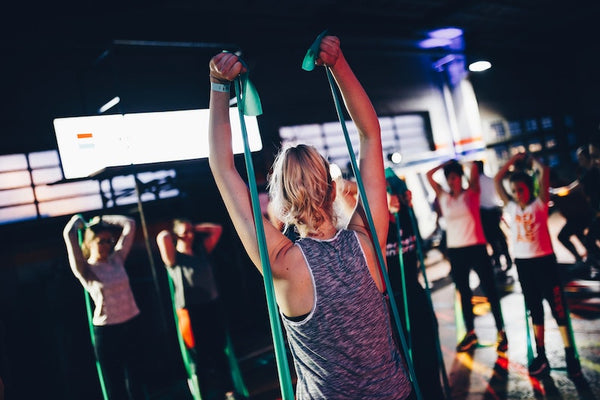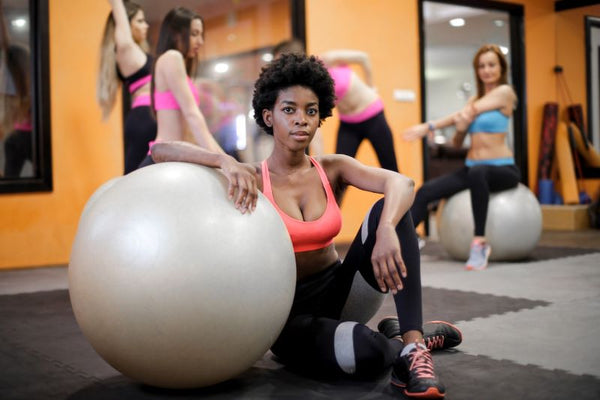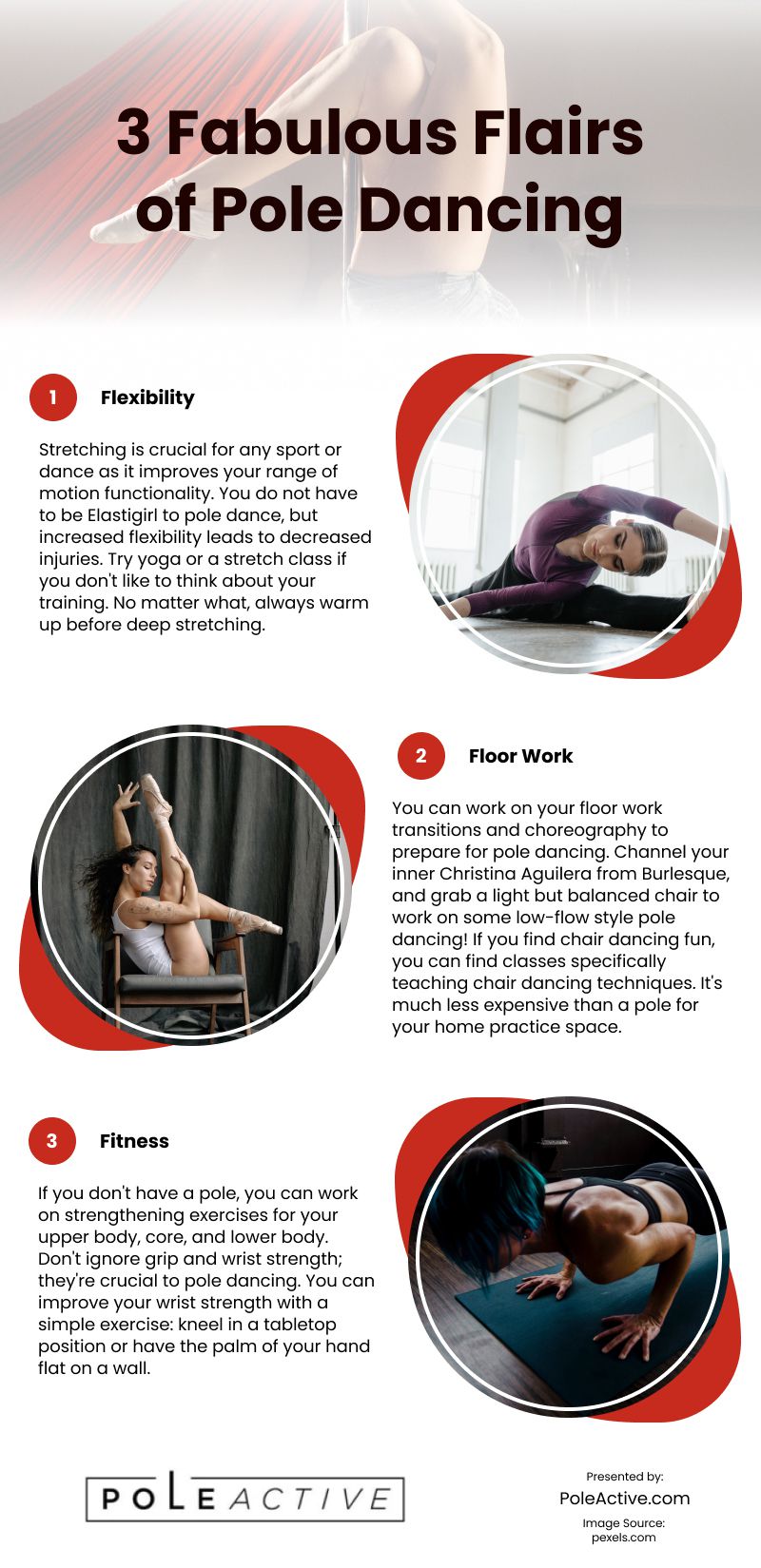News
-
Pole Dancing For Moms? 5 Reasons To Take A Class

As a mom, you are often the primary caregiver or default parent. It can be a challenge taking care of your children and the household, juggling schedules, working, and trying to take care of yourself.
What if there was an exercise that not only bolstered your physical health but also gave you self-care in the form of empowerment and fun? Here is why you should try pole dancing, especially as a mother. Pole dancing:
1. Boosts Your Confidence
Motherhood is physically tough on our bodies and can drain us mentally. Pole dancing can make you feel powerful and remind you that you are more than just that role. You can be sexy and a force to be reckoned with while still being Supermom.
Additionally, messages from media can make you feel bad about how your body looks or the scars and stretch marks you’ve earned. Pole dancing is about how you feel and what your body can do, not how it looks. Dancers come in all shapes and sizes. Treat yourself to some polewear that makes you feel confident and love how you look - there’s even plus-size dance wear. Not only will it boost your confidence, but it will boost your children’s confidence. They need parents that are body positive so that they can be too.
2. Helps Your Balance, Flexibility, and Strength
Whether you trip over flat ground or can walk a tightrope blindfolded, pole dancing will help your balance and coordination. You will also discover muscles you never knew you had and might start feeling like a bendy pretzel. There’s no way to perform inversions and spins without developing these skills. If you’ve already been cooking while balancing a toddler on one hip or juggling your coffee, keys, diaper bag, and a baby strapped to your chest, a Juliet spin will be a piece of cake.
3. Provides Stress Relief
Have you ever noticed that when you get stressed out, your kids get more mercurial as well? Your children’s emotional states depend on yours, so when you take time to decompress after swimming lessons, carpooling, and playdates, your children will calm down with you. Exercise also releases endorphins, so you’ll get natural mood boosters with every class you take.
4. Teaches You to Tackle Obstacles Head On
Parenting is full of challenges. Sometimes getting through the day as a mother can be a challenge. If you’ve worked for weeks on a pole dancing move, you can apply that perseverance to anything in your life. Or when you’ve looked at a pole and thought there’s no way you can climb the whole thing, but you try anyway and nail it, other obstacles you face can seem manageable. Potty training, a class full of rambunctious 6-year-olds full of sugar for your kid’s birthday, or a 12-hour road trip with two little ones in the back seat solo? You’ve got this, just like you got that cartwheel dismount.
5. Gives You a Community or Tribe
If you haven’t already discovered, motherhood can be incredibly isolating, and you may be missing the social life you used to have. Pole dancing is a welcoming and supportive community that will give you that sense of belonging you’ve been missing. It’s a great way to meet, socialize, and connect with other moms like you. Some studios even have specific classes for mothers, so you can bond and go over mother-approved moves in a more comfortable environment where everyone just gets it.
Is Pole Dancing Safe For Moms?
You may wonder if you can pole dance pregnant or postpartum. If you are pregnant, it is typically safe to pole dance. Most doctors advise it’s safe to continue any exercise you have already been doing with a few modifications. However, it’s always better to check with your OBGYN. If they clear you, you may find you are a bit warmer and struggling to maintain your grip to perform moves safely. Try some pole grip for sweaty hands for extra piece of mind.
Limit moves like backbends and moves that strain your abdominal region. Don’t try to master new skills; stick to sequences you can comfortably do. Remember to listen to your body and what is suitable for you. Some women can dance until they deliver, while others can only handle a few weeks before their body says no more. Don’t compare your body or your journey to anyone else’s.
Overall, pole dancing is a fun and challenging activity for moms. It’s an excellent whole-body workout that improves your mental well-being with opportunities for socialization and self-expression. Give it a chance, and you will be surprised how much you enjoy it.
Infographic
Here are a few reasons to give pole dancing a try, especially if you're a mother, who goes through physical and mental hardship. Pole dancing is often a tough and entertaining exercise, but it’s a terrific way to give your whole body a good workout, improve your mental health, and provide you with opportunities to express yourself.

Video
-
The 3 Fs to Practice Pole Dancing Without a Pole

Because the word pole is part of the name, you may think a pole is required to practice pole dancing. However, there are other ways you can easily practice and perfect your moves at home without it.
Pole dancing is not about just swinging on a pole. Initially, you can do exercises to build strength, grip, and flexibility as a beginner. You can also do some basic spins, planks, and freestyle moves that you can learn without a pole. You can use a wall or a chair as an alternative if necessary.
First, identify what level of dancer you are and what pole dancing will look like with your experience. As a beginner, that may be basic spins, learning grips, and sequences for getting into inversions. Set personal goals, so you know where to focus your off-pole training. Overall, there are three aspects to training for pole dancing without the pole:
1. Flexibility
You do not have to be Elastigirl to pole dance, but increased flexibility leads to decreased injuries. Stretching is crucial for any sport or dance as it improves your range of motion functionality. You could try yoga or a stretch class if you don’t like to think about your training, or there are specific off-pole flexibility courses. No matter what, always warm up before deep stretching.
2. Floor Work
Pole dancing isn’t always doing complicated tricks. You can’t have pole dancing without some floor work. You need smooth movements and seamless transitions to be a better all-around dancer. You can work on your floor work transitions and choreography to prepare for your pole dance. Even minor things like assessing, practicing, and perfecting the quality of your lines will improve your overall performance.
While working on your floor routine, you can practice some chair dancing. Channel your inner Christina Aguilera from Burlesque, and grab a light but balanced chair to work on some low-flow style pole dancing. You can practice various moves and splits while still training your muscles for pole dancing, as a chair is much less expensive than a pole for your home practice space. If you find chair dancing fun, you can find classes specifically teaching chair dancing techniques.
3. Fitness
Pole dancing is a blend of graceful moves, strengthening, and cardio. If you don’t have a pole, you can work on strengthening exercises for your upper body, core, and lower body. Try to incorporate push-ups, planks, V-sits or jack knife sit-ups, and wall sits. Check out more strengthening exercises here.
Choose your favorite cardio method and go for it. It can be another cardio-based dance class, power yoga to get cardio and strength, or a simple jog around your neighborhood. You will be surprised how effortless a pole class or complex move will feel after incorporating some training outside of class.
Don’t ignore grip and wrist strength; they’re crucial to pole dancing. Work on your grip with an inexpensive adjustable expander. You can improve your wrist strength with a simple exercise: kneel in a tabletop position or have the palm of your hand flat on a wall. Ensure your wrist, elbow, and shoulder are in line. Lift the heel of your wrist off the floor or push it away from the wall. Do this 15 to 20 times per wrist.
Stay Consistent
You will never get to it if you don’t set time aside for your training. Saying you will start practicing tomorrow is an easy out because tomorrow never comes. Put your workouts on your calendar and stick to your schedule.
If you’re struggling to get motivated, put on your pole fitness clothes and blast your pole workout playlist to get you pumped. Remember to track your progress. As improvements happen gradually over time, it can be hard to recognize just how far you’ve come unless you document your achievements along the way. If you work better off incentives, reward yourself with dance-related gear such as pole dancer shoes or pole garter shorts.
Don’t Forget to Visualize
Thanks to COVID-19 and lockdowns, many pole training videos are available online now. If you are a beginner trying to learn the basics and grasp sequences for moves, you can watch a clip and mentally run through the movements. This will help create new connections in your brain and help you remember the move without thinking about each step, making the sequence easier to put into practice.
You can visualize your whole routine or performance if you are more advanced. When you memorize your choreography, you can depend on muscle memory to execute the moves without concentrating on each part. This will your dance look much more cohesive and effortless.
Overall, pole dancing is here for you, and you will get out of it what you put into it. If you are happy learning casually with slower progression in a class environment, that’s perfect for you. If you want to progress faster, you know now that you don’t need a pole at home to work on your skills. Don’t let a lack of equipment or finances keep you from working on your dance form. There’s always a way, and a little creativity will help you find it.
Infographic
The fact that the term includes the word "pole" can lead you to believe that a pole is required to execute pole dancing. There are many distinct aspects to pole dancing and there are numerous methods for honing your skills at home. You may start by working out to get stronger, tougher at grasping and flexibility.

Video
-
Should pole dancing be an Olympic sport?
Pole dancing has many forms: sport, exotic, artistic, and freestyle. No matter what style you choose, they all require a good level of physical strength and endurance. There are creative and acrobatic elements similar to dance and gymnastics influencing the movement to make it an Olympic sport. These pole fans discuss their reasons for why or why not the Olympics should include it.
Yes, To Bring Recognition and Respect To The Athletes
My opinion is that pole dancing has the potential to be a legitimate Olympic sport. While some may argue that it is too provocative or sexual, the truth is that pole dancing requires immense strength, flexibility, and athleticism. It has already gained popularity as a competitive sport, with numerous competitions and championships held worldwide.
The International Pole Sports Federation has been pushing for pole dancing to be recognized as an Olympic sport since 2017. If pole dancing were to become an Olympic sport, it would undoubtedly bring greater recognition and respect to the athletes who participate in it.
Yes, But There Are Feasibility Considerations
As someone who is a fan of pole dancing, I am thrilled at the possibility of it becoming an Olympic sport. Pole dancing is a physically demanding and artistic form of exercise that requires strength, flexibility, and grace. It combines elements of dance, acrobatics, and fitness and has grown into a global sport with competitions and championships.
Including pole dancing in the Olympics would provide an opportunity for talented athletes from around the world to showcase their skills and compete at the highest level. It would also bring more visibility and legitimacy to pole dancing as a sport, dispelling misconceptions and promoting its athleticism and artistry.
Furthermore, as an Olympic sport, pole dancing could receive more funding and support, leading to increased opportunities for training, coaching, and development. This could also lead to greater acceptance and recognition of pole dancing as a legitimate athletic pursuit, which may help break down societal stigmas and barriers that some individuals may face.
However, I also understand that there may be differing opinions on whether pole dancing should be included in the Olympics, considering the cultural and historical context of the sport, as well as potential concerns related to judging criteria, doping regulations, and other logistical considerations.
As a fan of pole dancing, I would be excited to see it recognized as an Olympic sport, but I acknowledge that there may be valid perspectives on both sides of the debate. It would be important for thorough discussions and considerations to take place to determine the suitability and feasibility of including pole dancing in the Olympics.
Yes, It’s A Fun, Unique, and Challenging Sport
There are a few different aspects of pole dancing that make it an interesting sport to watch. Pole dancing is an incredibly physical and demanding sport that requires a lot of agility, strength, and cardiovascular endurance. In addition, the dancers must be skilled in aerial artistry, which means they must be able to perform intricate and difficult movements in the air.
In my opinion, pole dancing should be included as an Olympic sport. There are a lot of talented and skilled dancers out there, and I think they would make great athletes. Pole dancing is a really unique and challenging sport, and it would be a lot of fun to watch.
Yes, As It Breaks Down Associated Stereotypes and Stigma
My opinion is that pole dancing should be considered a legitimate and respectable Olympic sport. While some may view pole dancing as controversial or inappropriate, it requires immense physical strength, flexibility, and skill. It's a form of art that combines dance, acrobatics, and athleticism, which is no different from other sports, such as gymnastics or synchronized swimming.
Moreover, recognizing pole dancing as an Olympic sport can help break down stereotypes and the stigma associated with it, paving the way for more inclusivity and diversity in the sporting world. Ultimately, it's time to acknowledge the hard work and dedication of pole dancers and give them the recognition they deserve.
This is a crowdsourced article. Contributors' statements do not necessarily reflect the opinion of this website, other people, businesses, or other contributors.
-
7 Chinese Pole Dance Moves You’ll Want To Try

Chinese pole dancing is a different style than most are familiar with in the pole dancing community. Compared to modern pole dance, it’s less forgiving and requires a more precise approach. Not only in practice but also performances, it’s a group gig, so you might have seen some Chinese pole dancing if you have ever attended Cirque du Soleil. Dominic Lacasse, The Flag Man, has also brought recognition to the art of the Chinese pole. It’s one of the styles that modern pole developed from; however, there are some differences:
Customary For Males to Perform
Like mallakhamb, male performers or acrobats traditionally dominate Chinese pole. Because of its incredible ability to develop strength, stamina, and flexibility in one workout, men historically used it as training for wrestling or martial arts. In their respective societies, that tradition continues today. Chinese holds and poses require more upper-body strength because of this. You can see this in the classic strength move, the flag.
The Pole Height, Width, and Grip
Chinese poles are free-standing like stage poles. They are secured with circus rigging that holds the base directly to the floor and connects the top of the pole to the ground with long straps. If you get the chance to climb one, it has a little give to it, which is disconcerting the first time you sway with it.
In addition to extra looseness, the pole is tall compared to what you are used to; it ranges from 10 to 30 feet tall. The extra height allows for more acrobatic style moves like drops and flips you couldn’t pull off with the size of a standard pole. In addition to being staggeringly tall, the pole is wider than the standard pole, which can impact your grip. It gives those with larger hands an advantage.
The most significant difference between a standard and a Chinese pole is that the latter has a rubber coating. This provides an incredible amount of grip, allowing many more complex moves. However, it rules out any fun spins unless you want intense friction burns to accompany your jerky movements. To protect your skin, you will want full-coverage clothes, like a pole dancing bodysuit, which goes directly against all other pole dance clothing advice.
Despite all of these differences, here are some Chinese pole moves you can incorporate into your practice, even on your standard pole:
1. Frog
This is a rest position and the most important to learn so you can return to it any time you start to fatigue. It’s a traditional circus move that looks complex but will give you a nice break. You will have your knees bent outwards while placing your feet on the pole close to your thighs. You should look like a crouching frog with your hips open. Bring your dominant hand around the pole to lock in, straightening your dominant leg out if you prefer.
2. Chinese Pole Climb
This climb is another classic circus move you may have seen before, as it looks impressive on the taller poles. It’s different from a traditional pole climb, so you must have bare feet or wear grippy flat shoes, especially if you are on a regular dance pole. To start, you will place both feet flat on the pole, using the balls of your feet to push in. You will need to keep your arms bent and your hips towards the pole as you make your way to the top. If you start to fall back with straight arms, it’s challenging to continue the climb.
3. Lay Back
Nearly identical to the Fang movement in standard pole dancing, except you will grip with your thighs instead of your feet.
4. Gazelle Change
This move is more strenuous on a regular pole due to the lack of grip, so move slowly through the sequence until you get more comfortable. You can also use your hands on the pole while learning the move.
It is similar to the Gemini inversion, but you will keep your free leg straight and drop it over your back instead of the classic Gemini. Make sure you start higher on the pole, as you will descend slightly with each segment. Swing that free leg towards you while squeezing your thighs and swinging your torso around the pole. You will grip the pole with your armpit and change your leg into Reverse Gemini. Then you can repeat the move in the other direction and again for an incredible pole descent.
5. Hip Lock and Drop
It’s a variation on the Sit move. You will start with the pole centered at the top of the pole. Twist your legs as if you were doing the Barbed Wire, then you lean forward and round the pole to lock. You will slowly or quickly slide down the pole for the drop portion by relaxing your body to allow some slippage. It takes courage, but it’s invigorating if you can ignore the burn.
6. Hip Lock Walk Down
Again, you start in the Hip Lock position while straightening your left leg to walk your hands down the pole. You will squeeze your legs until you can hook your left foot on the back of the pole. You can hold this position without hands before preparing to do the next move, the Handstand.
7. Handstand
Like a Double Grip Straight Edge, you will start next to the pole, find your hand position, and kick up into the move.
Even if you are pole fit and experienced, you will feel the ache and burn after trying out these moves. It’s fun to try new methods and continue to expand your dance repertoire. If you find these interesting, seek out a Chinese pole class or private instructor to build up your craft. Just remember to wear your maximum coverage, non-sticky polewear if you do.
-
How do you know if pole dancing is for you?
Pole dancing is relatively new to the fitness studio world, so it can be daunting. How do you know you’ll enjoy it or can perform the moves before signing up for a class? These pole enthusiasts discuss what you need to know and how to determine if you’re ready to take the leap.
If There’s An Experienced Professional Teacher To Teach You
Pole dancing is right for you if there’s a studio you can access. I know that’s broad reasoning, but pole dancing can really be for everyone so long as an experienced professional is there to guide you through the beginning moves. Who knows? With the right teacher, you might even find you’re ready to take on moves past the beginning stage!
But the best advantage to having a teacher at a studio with professionally installed equipment is that under their trained, watchful eye you can operate with the confidence that you are safe. That feeling of security will give you a better workout and take you out of your comfort zone, which is really the beauty of pole dancing, to begin with.
If You Are Open To New Experiences
Pole dancing is a physically hard kind of dance that needs a great deal of strength and endurance. Before you try it, be sure you're in decent physical shape and don't have any underlying health concerns that would make it difficult.
Pole dancing studios are not as commonly available as other types of dance studios, so you'll need to do some research to discover one near you. Pole dancing requires the use of a vertical pole to accomplish spins, tricks, and other maneuvers. Pole dancing may be for you if you are comfortable with this form of dance and love exploring new movement patterns.
Openness to new experiences. Pole dancing is still relatively new to the popular dance industry and trying something new can be scary. Pole dancing may be a fulfilling and uplifting kind of dance if you're open to new experiences and prepared to move outside your comfort zone.
Overall, pole dancing may be a good fit for you if you're physically fit, comfortable with the motions involved, open to new experiences, and can find a studio near you. Just keep an open mind and a willingness to learn in mind, and you might discover that it's a tough and gratifying kind of dance that helps you grow strength, confidence, and grace.
If You Love To Dance and Movement-Based Exercise
Pole dancing has taken the fitness world by storm in recent years, and it's no surprise why. It's a unique combination of strength, flexibility, and artistic expression. But before diving in, there are a few things to consider to determine if pole dancing is a good fit for you. It's important to approach pole dancing with an open mind and willingness to learn, as it can be a physically and mentally challenging experience.
Additionally, it's important to be in good physical health and able to perform basic movements like lifting your own body weight. A supportive community is also crucial to staying motivated and progressing in your pole dancing journey. If you're someone who enjoys dance and movement-based exercises, then pole dancing may be a perfect addition to your fitness routine.
Remember, everyone's pole dancing journey is unique, so it's important to take your time and enjoy the process. As for submitting comments for the industry-specific website's crowdsourced article, share your personal experiences, tips, and advice for newcomers. Encouragement and inclusivity are key, and emphasizing the physical and mental benefits of pole dancing can help inspire others to give it a try.
Matthew Moore
Content Writer at FashMatch.If You Have The Physical Capabilities To Try It
Pole dancing is a physical activity that requires strength, flexibility, and stamina. It’s important to find out if you have the physical capabilities to do pole dancing before you decide to try it. You should also consider your comfort level with the activity and if you have any health concerns. Finally, it’s important to talk to an instructor to find out what types of moves are involved and how to do them safely.
This is a crowdsourced article. Contributors' statements do not necessarily reflect the opinion of this website, other people, businesses, or other contributors.








